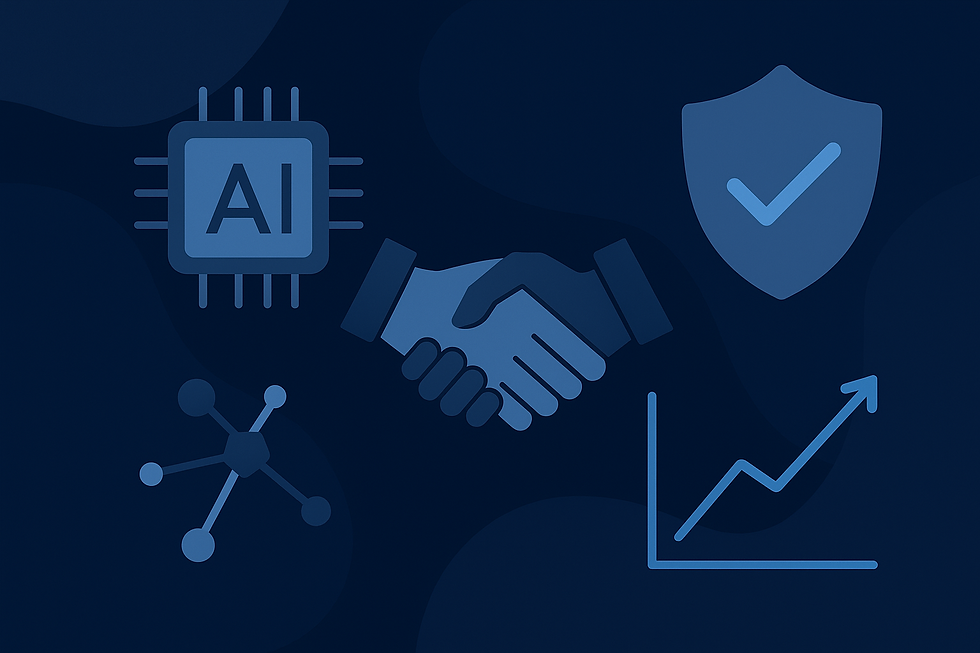What the EU AI Act Means for Startups: A Practical Compliance Primer
- jvourganas

- Jun 12
- 3 min read

Abstract
The EU AI Act, poised to become the world’s first comprehensive regulatory framework for artificial intelligence, introduces a risk-based approach to AI governance with sweeping implications for startups. While the Act aims to foster innovation, its obligations can seem complex and daunting for early-stage companies. This article translates the legal language into clear, actionable guidance tailored for startups. By mapping AI use cases to the Act’s risk categories, minimal, limited, high, and prohibited, we offer a tiered compliance roadmap that prioritizes strategic clarity, product integrity, and sustainable growth.
Introduction: Regulation Meets Innovation
AI is evolving faster than the regulatory landscape can adapt, until now. The EU AI Act marks a turning point, not only for Big Tech but for startups building AI-driven solutions in fintech, healthtech, mobility, education, and beyond. The message is clear: if your AI impacts EU users, compliance is no longer optional.
Startups face a double bind. They are expected to scale responsibly while navigating a law designed to regulate a vast spectrum of AI capabilities. Our goal in this primer is to strip away the jargon and show exactly what compliance looks like at each level of risk, with a special focus on practical, resource-conscious implementation.
Understanding the Risk-Based Classification
The EU AI Act structures its obligations around four risk levels:
Minimal Risk: Includes spam filters, inventory management systems, or AI that does not affect people’s rights or safety. These applications are largely exempt.
Action: No mandatory requirements, but consider voluntary codes of conduct to future-proof your stack.
Limited Risk: Includes AI that interacts with users but poses low risk, such as chatbots or AI in customer service.
Action: Transparency obligations apply. Inform users they’re interacting with an AI system. Document system design and maintain user documentation.
High Risk: Covers AI in critical areas like hiring, education, healthcare, credit scoring, and law enforcement.
Action: These systems must meet strict requirements:
Risk management and impact assessments
Data governance and quality standards
Human oversight protocols
Record-keeping, traceability, and logging
Robust documentation for notified bodies
Prohibited AI: Systems that manipulate human behavior, exploit vulnerabilities, or involve social scoring are banned outright.
Action: Reassess product features immediately. Avoid deploying or developing such systems within the EU.
Mapping Startup Use Cases to Risk Levels
A mental health chatbot → Likely Limited Risk; requires clear user notification.
An AI recruitment tool → High Risk; must follow rigorous documentation and fairness standards.
A generative AI productivity app → Limited or Minimal Risk, depending on use.
An algorithm for fraud detection in fintech → Likely High Risk, especially if tied to credit decisions.
Compliance Without the Legal Overhead
Many startups fear that compliance means bureaucratic paralysis. It doesn’t have to. Here are practical tips:
Risk Triage Early: Map your product to a risk level from day one. Build risk-tier-aligned design principles into your MVP.
Document Proactively: Even minimal and limited-risk systems benefit from early documentation.
Design for Oversight: Embed human-in-the-loop review where feasible. It’s not just a regulation, it’s a trust builder.
Leverage Open Frameworks: Tools like Model Cards, Datasheets for Datasets, and FactSheets align well with the Act’s documentation philosophy.
The Opportunity Beneath the Compliance
The EU AI Act isn’t just a regulatory challenge, it’s a branding opportunity. Compliance signals trustworthiness, accountability, and foresight. Early adopters of best practices will earn a reputational edge and reduce friction with investors and regulators alike.
Overall: Build Smart, Build Fair
Startups don’t have the luxury to ignore regulation. But they also don’t need to fear it. The EU AI Act provides a blueprint for building AI that is not just innovative, but safe, just, and rights-respecting. With the right mindset and strategies, compliance becomes a product asset, not a liability.
Your next competitive advantage isn’t just in what your AI can do. It’s in how responsibly you choose to build it.




Comments